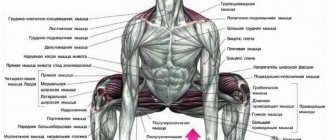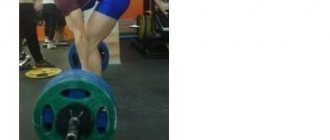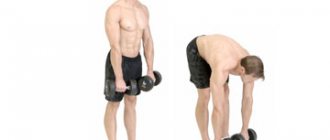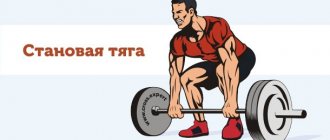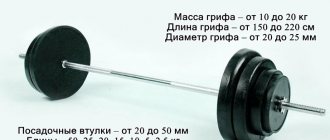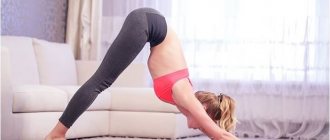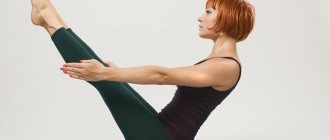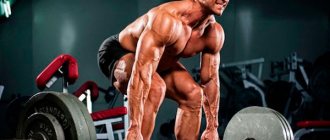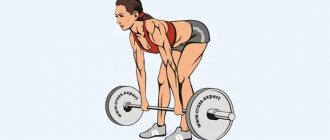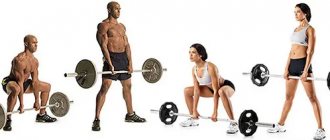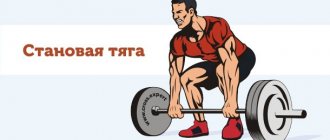The deadlift, also called the stiff leg row, is a basic exercise for strengthening the back and targeting the hamstrings and glutes. This type of deadlift is absent in the competitive powerlifting program, since the peculiarities of its technique do not allow working with large weights. However, most training enthusiasts are not interested in the competitive process, but in improving their physical fitness. Performing straight-legged deadlifts allows you to contract and stretch the target muscles in one exercise, which is great for achieving this goal.
- Deadlift: what works and what muscles the deadlift pumps
- Benefits of deadlifts for men and girls
- Deadlift technique, how to do Romanian deadlifts correctly
- Important nuances: what you should pay special attention to
- Video: straight-legged deadlift technique
- Possible technical errors
- What is the difference between a deadlift and a classic deadlift, what is the difference?
- Table: differences between deadlift and classic deadlift
- How to achieve maximum effect: recommendations for performing the exercise for men and women
When can you do the exercise?
Unlike the classic deadlift, the deadlift (on straight legs) is ideal for girls and beginner athletes. It can be included in the training program as soon as the practitioner can stretch the muscles of the lower back and the back of the legs to the desired degree.
While there is no stretching, you cannot do the exercise. Otherwise, you will round your lower back, which should not be allowed. And you won’t be able to lower the weight to the desired height. Stretching in most exercises is the basis of proper technique.
If you have back pain, stiff-legged deadlifts may be painful. When this happens, train your back, abs, and leg flexors separately in machines. Once you have strengthened them sufficiently, you can move on to free weights. Then on to the classics.
Cardio without cardio
And last but not least are the benefits of unilateral exercises for training the cardiovascular and metabolic systems. I'll never forget how out of breath I was in the middle of a set of lunges when I tried them as part of a high-volume program. My heart just jumped out of my chest, and suddenly I remembered that I had already tried this before and decided not to repeat it again. It is clear that performing the exercise separately on each leg takes twice as long as on both legs at once. In reality, it takes even more time - you slow down due to the complexity of the movement, are distracted by maintaining balance, etc.
All this means is that the time under tension is twice as long, the metabolic cost is twice as high, the gasps are twice as long and the heart beat is also twice as high as when performing the same exercise on two legs. Therefore, unilateral exercises are now always at the heart of my general physical training programs. Three or four one-legged exercises - lunges, bridges, squats and deadlifts - are performed in a row without breaks, 10 repetitions per leg in each.
Muscle work
Performing deadlifts or deadlifts on straight legs involves working several muscle groups at once. The muscles of the back and back of the thighs receive the greatest load. The quadriceps here, unlike the classic version of the deadlift, are not involved, since the legs remain straight all the time.
Main working muscles:
- Back extensors.
- Thigh biceps.
- Large gluteal muscles.
Main working muscles.
Additional stress is placed on the inner thighs, abs, forearms, and upper back.
Confusion in concepts
Please note that there are a lot of exercises for the lower back and back of the legs. See for yourself:
- Deadlift (and all its variations).
- Romanian deadlift (with slightly bent legs).
- Deadlift or straight-legged deadlift.
It would be more correct to say straight-legged deadlift, just like the Romanian deadlift.
Because there are different types of rows, maybe, for example, bent over rows of barbells or dumbbells. And to be even more precise, this is, for example, a deadlift on straight legs with dumbbells. Simply saying deadlift with a barbell is not enough.
So, you understand that these are slightly different exercises. Next, we will list the main differences between them.
Now let's look at what the correct deadlift technique should be.
Why does a woman need deadlifts?
Deadlifting can help a woman achieve a huge number of goals. Deadlift will help you:
- get rid of excess weight (provided that you do not eat the daily norm of the entire Kazakh people);
- gain muscle mass (again, provided that you eat right);
- work on the buttocks and thighs (depending on the technique, you can work on individual thigh muscles);
- find a good man.
As we can see, deadlift is very useful for girls. And then I’ll tell you which option, in my opinion, would be ideal.
Execution technique
First, we need to warm up and warm up our ligaments and muscles. Before performing the exercise, we recommend slightly stretching the back of your thighs, calves, and lower back.
Execution order:
- Get into the starting position with weight: we put our feet shoulder-length, you can turn your toes slightly to the sides or leave them parallel to each other.
- It is necessary to bring your shoulder blades together, look straight. There is a deflection in the lower back (the pelvis is pushed back). Now let's remind you about breathing: as you go down, you inhale. Exhalation is on the rise Everything is as usual - effort comes on exhalation, relaxation on inhalation. Just remember this simple principle of breathing.
- Legs straightened at the knees! That’s why this type of exercise is called straight-legged deadlift. Hold the barbell shoulder-width apart with an overhand grip.
- We begin to move the bar or barbell straight down towards the middle of each foot. To do this, your feet must be level with each other!
- The back remains straight, we bend by bending the lower back and moving the pelvis back. We move the pelvis back to maintain balance so as not to fall forward. Do not forget that you are moving your buttocks back not by bending your knees, but by bending all your legs back. That is, your legs will go beyond the line perpendicular to the floor. On the one hand, it turns out that the pelvis does not move at all, but on the other hand, it deviates along with the legs. But all movement is carried out due to the efforts of the lower back.
- Until you have good flexibility, you will not lower the barbell below your knee. Over time, you will be able to reach the floor. We're talking about a barbell, not an empty bar. To lower an empty bar to the floor you need to stretch very well. And the larger the diameter of the pancakes, the easier it is to perform the exercise. For girls, at first, a fitness bar or body bar is better.
- We pull the weight with the muscles of the lower back. During the exercise, you should feel how it and the back of the thigh work. When you return to the starting point, squeeze your shoulder blades together.
Naturally, in this exercise you will not use the same weights that can be lifted in a classic deadlift. Lifting the weight is done through the lower back and upper hamstrings rather than through the strong leg extensors.
The diagram clearly shows that the pelvis is pulled back, and the legs remain almost straight.
Differences between types of traction
Below we will look at how the straight leg deadlift, the Romanian deadlift and the classic deadlift differ from each other.
Deadlift on straight legs from Romanian
The Romanian lumbar lift has a number of differences from the type of deadlift we are discussing:
- Knees bent. And the lower you bend, the greater this angle. You compensate for the pelvis moving backward by bending your knees. This does not mean that you should bend your knees too much, no. The angle is small - up to 10-15 degrees. This is enough to complete the exercise.
- We begin to move by moving the pelvis back. In the deadlift we tilt the body, but here it’s from the pelvis. He walked backwards, initiating lumbar flexion.
- We lower the barbell just below the knee, because it will be difficult to keep your back straight. In general, we go as low as our back allows. The Romanian deadlift is less dependent on your stretch because you bend your knees.
- The Romanian get-up puts a lot of stress on the glutes because when you return to the starting point, you have to squeeze them and push your pelvis forward. This is a good visual difference between the two exercises.
The Romanian barbell deadlift, like the stiff-legged deadlift, is more suitable for girls.
Romanian version - knees slightly bent to maintain a straight back position.
Romanian from classical
The Romanian get-up is not designed for footwork. The knees bend so that your flexibility does not interfere with proper bending. With a deadlift, you squat down to apply the load to your back and legs. Thanks to this, both legs and back work when lifting and lowering the weight. This allows you to lift much heavier weights than the Romanian lift. Therefore, this is the base. And for girls it’s only suitable if they want to seriously increase their strength.
Classic execution: in the starting position, the legs are bent. The weight also rises due to the extension of the legs.
Dead from classic
It seems that everything is obvious here - legs. Straight or bent - that's the difference. Let us remind you that the classic deadlift on bent legs means squats to an incomplete amplitude, and not just their bent state. The latter is observed in the Romanian deadlift. But deadlifts with straight legs do not allow bending of the legs. Although, the knees cannot be kept locked. You should relax them a little. There will still be an angle of 1-2 degrees. From the outside it looks like straight legs.
Frequency of training to achieve results
The deadlift is considered a resource-intensive exercise that allows you to quickly form a strong muscular frame of the body. The technique creates a significant biomechanical load on most muscle groups. At such high intensity, the body requires a long rest.
The frequency of training is an individual concept, which depends on the initial sports readiness and physiological characteristics of the body. Experts do not recommend performing such complexes more than 2-3 times a week. This does not apply to professional athletes preparing for competitions.
Main mistakes
- We are not doing a Romanian lift, so our legs are straight. Stretch to perform the exercise correctly and deeply. You can pre-train on a hyperextension machine. Try to make the deepest possible movements in it with a straight back. We find this to be a very effective preparation for stiff-legged deadlifts combined with stretching.
- Don't put your head down. Let's look ahead. It is advisable to stand in front of a mirror.
- When you take on a lot of weight, you begin to round your back. Because the weight is pulled not by the lower back, which lacks strength, but by the entire back. This is where all the injuries begin. It is enough to round your lower back and your entire back will follow suit.
- Shrugs should not be done together with deadlifts. Initially, fix your shoulders so that they are in a normal straightened position, and not raised up. We are pumping not the trapezius, but the lower back.
If the exercises are so similar, what should we do?
First of all, the bent leg deadlift is designed to increase mass and strength, and this is the base. The Romanian get-up (aka Romanian deadlift) and straight-legged deadlift are designed to work isolatedly on the buttocks and hamstrings, which is extremely important for girls. They don't put as much stress on the spine, but can lead to injury if you forget how to do the exercises correctly.
Before doing a classic deadlift, you need to work with simpler exercises to strengthen your back. And before them is a month of hyperextension and stretching.
So, when your stretching for some reason does not want to progress, you can stop at the Romanian deadlift. And if you can stretch enough, then do deadlifts with straight legs.
What to replace it with?
If it hurts to do deadlifts, then for the back of the thighs and lower back, try the following:
- Pulling your legs back with weights.
- Reverse hyperextension.
- Leg extension in the simulator.
- Leg press on the back of the thigh.
- Regular hyperextension.
Strengthen your lower back and leg muscles with these exercises, then try deadlifts. You can use an orthopedic belt if you have one. Or your doctor will prescribe it for you. A rigid athletic belt is not effective in this case.
Safety regulations
- Back hurts during and after exercise. You need to do hyperextensions without weights for one month to strengthen your lower back. At the same time, stretch your muscles so that your technique does not suffer from lack of stretching. Before the exercise, you can smear your back with warming ointments, you can also use painkillers. The main principle is do no harm! If the pain remains after a month of hyperextension, you should see a specialist.
- My knees hurt. It's difficult to offer anything here. Try wrapping elastic bandages around your knees. Sometimes this option helps. Sometimes not. Go to a specialist and find out if you have flat feet. If you have them, order special insoles and place them in your shoes for the gym.
- You feel dizzy when you bend over. Contact a neurologist. This shouldn’t happen (unless you are 60 years old, of course – these are age-related characteristics of the body).
